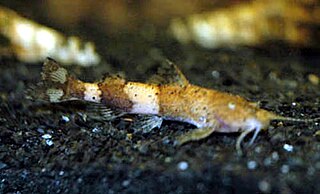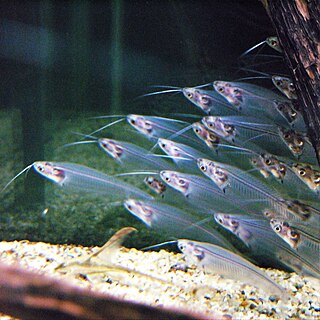
Clarias is a genus of catfishes of the family Clariidae, the airbreathing catfishes. The name is derived from the Greek chlaros, which means lively, in reference to the ability of the fish to live for a long time out of water.

Pseudolaguvia is a genus of South Asian river catfishes. These species inhabit hill streams and large rivers. P. tenebricosa is found in fast running, clear water; the river has a sandy bottom and numerous rocks and boulders and aquatic vegetation is absent. P. inornata is from clear, shallow, moderately flowing streams with a predominantly sandy bottom. P. muricata is found in clear, shallow, slow-flowing streams with a mixed substrate of sand and detritus; these fish are found amongst detritus in areas with current. P. ferula is also found in swift flowing waters with a mixed rocky/sandy bottom.

Glyptothorax is a genus of catfishes order Siluriformes of the family Sisoridae. It is the most species-rich and widely distributed genus in the family with new species being discovered on a regular basis. These species are distributed in the Black Sea basin, northern Turkey, south and east to the Yangtze River drainage in China and south throughout Indo-China to Java, Indonesia. They are found in Asia Minor and southwards to Southeast Asia. The genus is very diverse in the Indian subcontinent. Southeast Asian species tend to have restricted distributions.

Akysis is the largest genus of catfishes of the family Akysidae.

Kryptopterus is a genus of catfishes belonging to the family Siluridae. They are found in freshwater throughout Southeast Asia. The scientific name comes from Ancient Greek kryptós + ptéryx. It refers to the reduced or even entirely absent dorsal fin of these catfishes.

Peckoltia is a genus of small South American armored suckermouth catfishes. Many of these fish are popular aquarium fish.

Hemibagrus is a genus of catfishes of the family Bagridae.
Erethistoides is a genus of South Asian river catfishes.

Mystus is a genus of fish in the family Bagridae native to Asia. Phylogenetic relationships within this genus are poorly understood, though it has been suggested that there are two major lineages.

Olyra is a genus of catfishes of the family Bagridae. This genus occurs throughout South Asia and western Indochina, from India to western Thailand.

Leiocassis is a genus of bagrid catfishes found mostly in Southeast Asia with some species occurring in China.
Pseudomystus is a genus of catfishes of the family Bagridae.
Gogo is a small genus of catfishes of the family Anchariidae. It includes four species.

Pseudecheneis is a genus of sisorid catfishes native to Asia.

Amblyceps is a genus of fish in the family Amblycipitidae. The genera Amblyceps and Liobagrus are sister group pair that is, in turn, sister to Xiurenbagrus. These species are easily distinguished by the presence of pinnate processes along with the median caudal-fin rays, a prominent cup-like skin flap above the base of the pectoral spine, and the adipose fin largely separate from the caudal fin. In most species the caudal fin is deeply forked; A. apangi and A. murraystuarti differ in having their caudal fin truncate. Amblyceps species may reach about 100 millimetres (3.94 in) SL.
Exostoma is a genus of sisorid catfishes native to Asia. These species are distributed in the Brahmaputra drainage of north-eastern India, and east and south to the Salween drainages in Burma. E. berdmorei is found in the Sittang and Salween drainages in Burma. E. labiatum is known from the Brahmaputra drainage in north-eastern India, but has also been recorded in the Salween drainage in Burma, the Ayeyarwady drainage in China, and the Brahmaputra drainage in Tibet and Burma. E. stuarti is from the Ayeyarwady River of Burma and India; however, it has not been collected since its original discovery. E. labiatum is found in mountain rapids.

Microsynodontis is a genus of upside-down catfishes native to freshwater rivers in western Africa. The genus was originally described by British-Belgian zoologist George Albert Boulenger in 1903 based upon the type species Microsynodontis batesii. The name microsynodontis comes from the Greek word mikro, meaning small, and the Greek term synodon, meaning "with the teeth all growing together".
Ompok is a genus of fish in the family Siluridae found in lakes and large rivers throughout South and Southeast Asia.
Nanobagrus nebulosus is a species of bagrid catfish endemic to Malaysia where it is found in the Endau and Sedili River drainages in the southeastern Malay Peninsula. It grows to a length of 3.5 cm and has a brown body with three rows of cream-colored spots that are found above, along, and below the lateral line.












